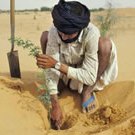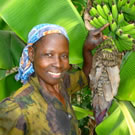One of the biggest challenges in development is helping people rise out of poverty by increasing their income levels. It’s very popular these days for NGOs to encourage community members to become entrepreneurs and to start businesses. The best people to mentor new entrepreneurs are successful, experienced businesspeople. They’ve learned through the school of hard knocks what works successfully and what things to avoid in starting and running businesses
Unfortunately, NGO field staff don’t necessarily have business backgrounds. Community members don’t necessarily have entrepreneurial drive nor skills. This isn’t a good recipe for rising out of poverty. I have frequently seen piles of handicrafts gathering dust in a warehouse that a well-meaning NGO staffer suggested that community members make—but that they were never able to sell. This creates a negative impact on the community for the time and materials they expended in the production of the handicrafts.
| |
In the agricultural sector, a solution to this over the past six or eight years has been to connect smallholder farmers to existing markets. The way that this is normally done is to facilitate a group of smallholder farmers into forming a farmers association. This allows them to have more power in sales negotiations, and it also allows them to produce as a unit a larger quantity of crops.
|
There are different existing markets—and buyers for these markets—in developing nations. At the top, are exporters and the owners of large national stores. There are buyers for these markets operating at different levels—from local farmers aggregating crops to wholesale buyers to food processors preparing food for export. Frequently these buyers don’t have access to sufficient quantities of produce to meet their sales opportunities. For them to be able to work with an association of farmers is a good opportunity.
Because of this, they will frequently invest in farmer associations by providing three important things:
| |
1. Training in the production of an appropriate crop for association members.
2. The provision of inputs (such as seeds and fertilizer) and materials (such as tools, or poles and string for climbing crops) on credit to be applied to future sales.
3. Ongoing extension. Frequently, these large organizations have in-house extension agents which work with associations of farmers to help keep production levels and quality up.
|
The process for making these market connections is to begin forming the association. This might take six months because of the learning curve. The second step would be to survey businesses and buyers to find out who has a routine need for what types of products? The reason this is a good idea is because an association of smallholder farmers might not make the best decision initially on their own about what to grow. A simple survey can help them see what’s in demand and how much it sells for. Upon analyzing the information the association’s members can make the decision to approach one buyer or another to get started. In approaching the buyer, one of the things to discuss is what sort of training and support will the buyer be able to give to the new association.
In Guatemala, I have seen this work successfully in a number of situations both for export sales and for domestic sales to stores.
| |
But there are also other markets available to an Association of farmers. The open air market in the next large town may have vendors which need specific crops. It might be an opportunity for the association to rent a stand in an open-air market to sell products that are in demand. Lastly, there may be strong need in their own community (or cluster of communities) for produce on a door-to-door basis. Consequently, a simple survey of local markets might be a good idea too.
|
I just read an excellent article published in Capacity.org. It’s titled “Making markets work for smallholders?” In this article, the authors point out a number of challenges with the market-based approach described above. First, they point out that many organizations promoting market-based agricultural sales assumed that there are “inclusive” businesses that want to work with new entrepreneurs belonging to a new association. Some opponents suggest that this might be exposing small-scale producers to highly demanding and volatile markets.
| |
The authors propose the concept of “producer agency”. The idea behind this is to facilitate an increase in the capacity of producers to make informed choices and to act on those choices—in an effort to deal effectively with sophisticated businesses promising access to new high value markets..
|
Many people in feel that the best way to develop small-scale producers is to connect well organized producers into trade arrangements with inclusive businesses where producers have a say in the trade relations. Otherwise, they feel that high-value market links can perpetuate top-down models of development in which farmers decisions are made for them by bringing producers into trading relationships under conditions of very unequal negotiating power and very unequal information.
The authors also point out that high-value export markets and cash crops could be being produced at the expense of staple crops, and at the expense of household and regional food security—and that “smallholders might be better off supplying the much larger domestic wholesale and informal markets.” Domestic markets may become increasingly attractive option.
| |
The article concludes by re-emphasizing the importance of producer agency—”by agency, we mean the capacity of producers—as individuals and as organizations—to make informed choices in the face of external agendas and powerful actors, and the capacity to act on those choices.” Download a copy of the article here.
|
In summary, a market based approach to the sale of produce that is supported by strong farmer associations where farmers can make informed decisions and can participate at the bargaining table has a better chance of working for the benefit of the smallholder farmer. High-value export crops might not be the best decision for smallholder farmers—when there exist markets for traditional crops and staples, and when the provision of these crops can be in the support of local and regional food security.
Therefore, one of the best things a field practitioner can do would be to help strengthen a farmer association that they’re involved with and to provide them with information about both cash crop markets and local markets—and then let the members begin making informed decisions about their futures.
Sincerely,
Tim Magee
Executive Director
Would you like to subscribe to this newsletter?
The Center for Sustainable Development specializes in providing sound, evidence-based information, tools and training for humanitarian development professionals worldwide. CSDi is a 501(c)(3) nonprofit organization.



